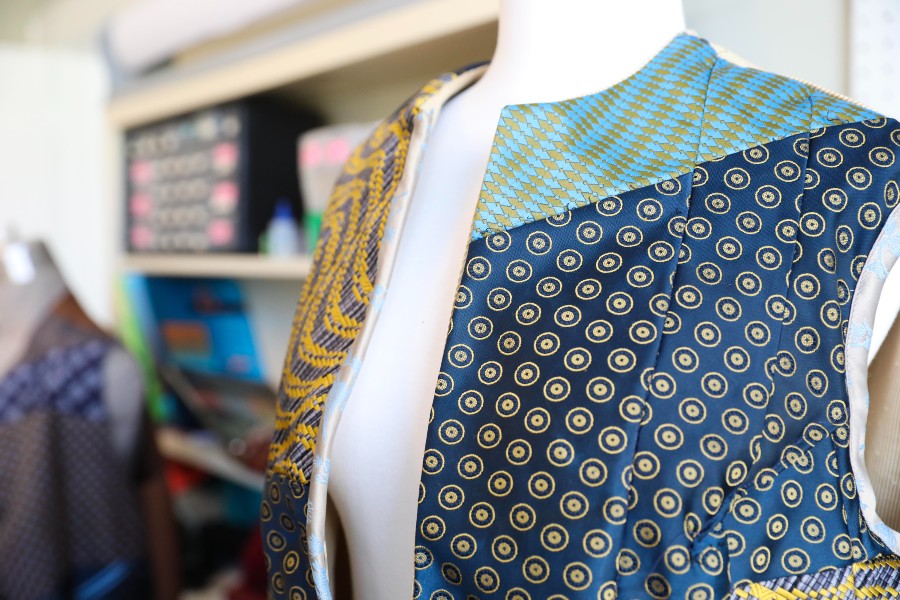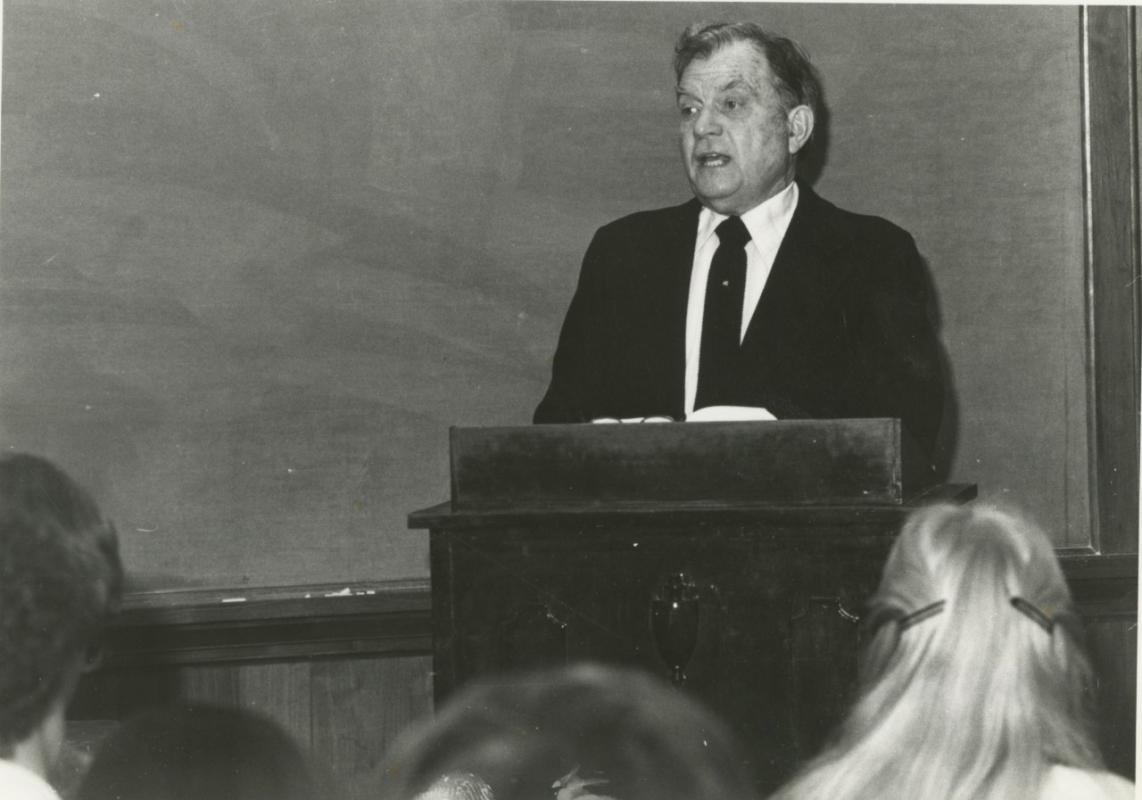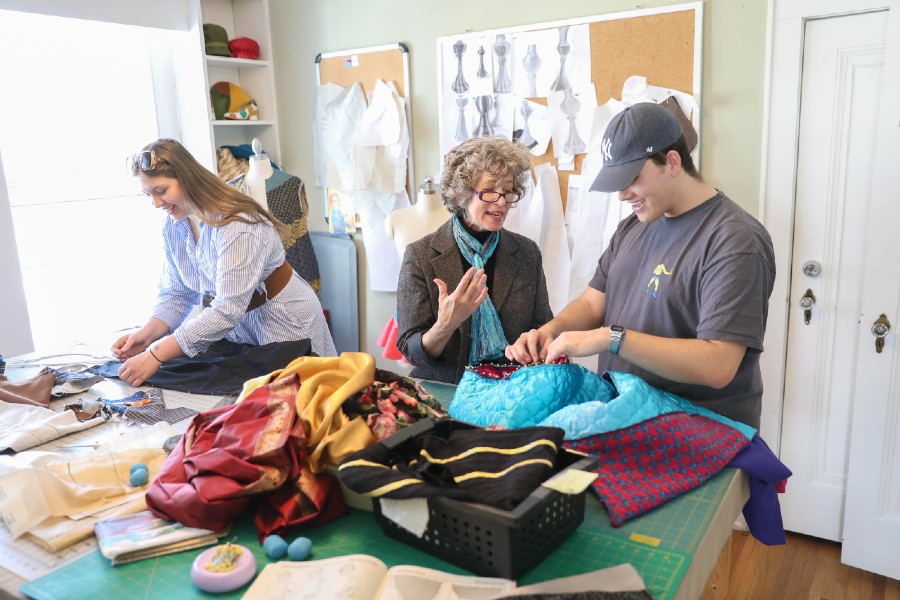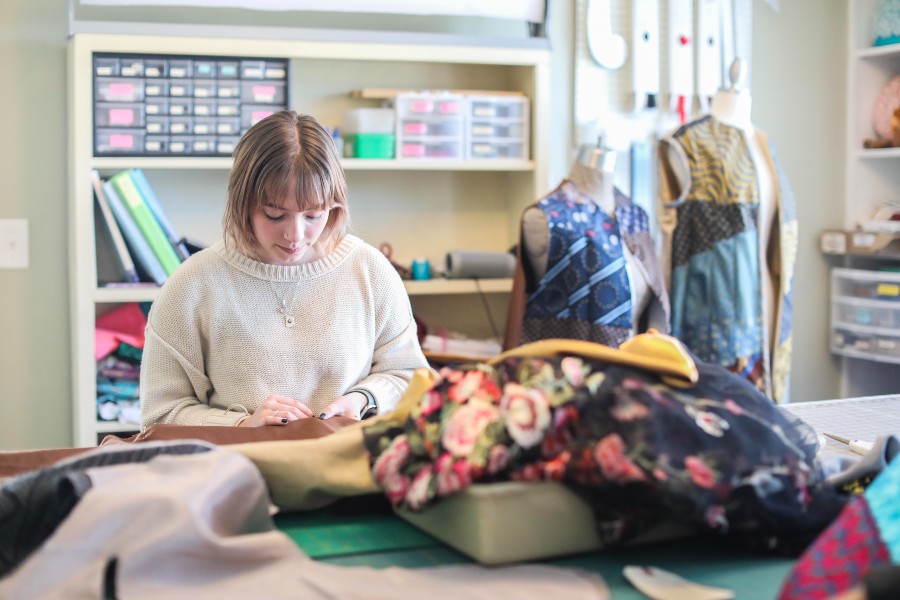Legacy of English professor Morris Landiss ties costume innovation to 'Hamlet' production
June Kingsbury creates runway fashions for the stage.
Keely Hagan |

These costumes for Rosencrantz and Guildenstern was created from piecing together neckties once worn by long-time English department Chair Morris P. Landiss.
In the heart of creative collaboration lies the unexpected, where innovation meets tradition, and artistry breathes new life into challenging classics.
Lipscomb College of Entertainment & the Arts is breathing new life into two characters in Shakespeare’s Hamlet this month through an innovative link to a Lipscomb alumnus and long-time English chair and professor: the late Morris P. Landiss (’31).
As a creative way to bring the director’s vision of a blend of medieval and modern to the stage, Department of Theatre resident costume designer and shop manager June Kingsbury, used a treasure trove of 150 donated neckties from the Landiss family to create the costumes for Rosencrantz and Guildenstern.
Shakespeare would certainly have been among the topics Morris taught in his classroom during his years at Lipscomb. His son, Shipley Landiss (LA ’78) says, “As Shakespeare writes in As You Like It, ‘All the world’s a stage, and all the men and women merely players.’ My dad was fortunate to have been one of the ‘players’ in the English department at Lipscomb, and I am sure that he would be delighted that his ties are gracing the Lipscomb stage for this production of Hamlet.”

Morris P. Landiss
“Most of the ties are from the ’70s, which I know only because they’re so wide,” Kingsbury chuckles as she describes the colorful array of neckties. “It’s wonderful for me to have that much material and fortunately, a lot of the ties are in the same color family.”
Morris Landiss was among a batch of faculty hired in the 1940s to serve a huge influx of students after World War II. Morris also served on the Bible faculty in the 1950s and was an advisor for The Tower literary magazine. He passed away in 1984.
Before his death, Morris Landiss established the fund that bears his name and supports the annual Landiss Lecture Series. He did so out of a belief that students need experiences beyond the classroom to encourage their intellectual growth. He dreamed of bringing to the campus writers and critics along with scholars of national reputation to challenge the minds of those in this academic community as well as in the community at large.
Read more about this year’s Landiss Lecture with author David French on April 16.

June Kingsbury, students creating stage costumes
Hamlet by William Shakespeare, directed by Theatre Assistant Professor Nat McIntyre, will be performed in Collins Alumni Auditorium, April 18-28, with matinees for local high school students April 16-26 and public performances April 19, 20, 26, 27 at 7:30 p.m. and April 21, 28 at 2:30 p.m. Shakespeare’s tragic masterpiece is about grief, madness and revenge, and is recommended for ages 12 and older.
Buy tickets for Lipscomb's production of Hamlet here.
With over 30 actors in the production, Kingsbury and her talented team of 21 students must outfit them all. “I couldn’t do this without my students,” she says and notes that some costumes must be duplicated to fit actors of various sizes. “We have to be prepared for replacements from the get-go,” she says, recounting past instances of cast changes during performances that required immediate costume changes.
This production of Hamlet uniquely blends medieval and modern, curated by McIntyre. “When he asked for those two time periods to be combined, my feeling was to design the costumes like runway fashion. They are really out-there looks that nobody would wear on the street,” Kingsbury says.
Her designs bridge the gap between eras, infusing medieval silhouettes with contemporary fabrics and twists. She asked herself, “What can I do with shapes that are more often medieval but do them in modern fabrics or with a more modern twist?”
The result are costumes that extend beyond aesthetics to serve a crucial narrative function. “Costume design includes finding ways to identify characters... but also making it so the audience isn’t looking at everybody in the same identical look,” Kingsbury explains.
“People get anxious when they start hearing language that they fear they’re not going to understand,” she says. By making the visuals more relatable, Kingsbury aims to ease the audience into Shakespeare’s intricate world. She uses the colors of the costumes to subtly group characters by families or other relevant relationships that help the audience differentiate between the characters and better understand the context of their roles and actions.

The costumes made from Morris Landiss' neckties can be seen in background of the costume shop, where this student works on other costumes for the upcoming production.
This is where the neckties take center stage. Transformed into vests, these relics of the past add a vibrant flair to the production while connecting the two characters who wear them.
Creating the vests is a meticulous process, Kingsbury says. “First, you have to take the ties apart and then you piece them together, akin to crafting a quilt,” Kingsbury says.
While the work can be challenging, she says her students, who are all acting, musical theater and technical theater students, are eager to learn the art of costume design and enjoy bringing her vision to life. “I have found that the students are really excited when they see what we’re doing and combining and creating,” she says.
In the realm of theater, where the old meets the new, Kingsbury demonstrates innovation and creativity, refreshing timeless classics one costume at a time.